Abstract
The prediction of the quasi-static response of industrial laminate structures requires to use fine descriptions of the material, especially when debonding is involved. Even when modeled at the mesoscale, the computation of these structures results in very large numerical problems. In this paper, the exact mesoscale solution is sought using parallel iterative solvers. The LaTIn-based mixed domain decomposition method makes it very easy to handle the complex description of the structure; moreover the provided multiscale features enable us to deal with numerical difficulties at their natural scale; we present the various enhancements we developed to ensure the scalability of the method. An extension of the method designed to handle instabilities is also presented.
Similar content being viewed by others
References
Allix O, Corigliano A (1996) Modeling and simulation of crack propagation in mixed-modes interlaminar fracture specimens. Int J Fract 77: 11–140
Allix O, Ladevèze P (1992) Interlaminar interface modelling for the prediction of delamination. Comput Struct 22: 235–242
Allix O, Lévêque D, Perret L (1998) Identification and forecast of delamination in composite laminates by an interlaminar interface model. Compos Sci Technol 58: 671–678
Ben Dhia H, Rateau G (2005) The arlequin method as a flexible engineering design tool. Int J Numer Methods Eng 62(11): 1442–1462
Cresta P, Allix O, Rey C, Guinard S (2007) Nonlinear localization strategies for domain decomposition methods in structural mechanics. Comput Methods Appl Mech Eng 196: 1436–1446
Crisfield MA (1981) A fast incremental iterative solution procedure that handles ’snap-through’. Comput Struct 13: 55–62
De Borst R, Remmers JC (2006) Computational modelling of delamination. Compos Sci Technol 66: 713–722
Dostál Z, Horák D, Vlach O (2007) Feti-based algorithms for modelling of fibrous composite materials with debonding. Math Comput Simul 76: 57–64
Farhat C, Roux FX (1991) A method of finite element tearing and interconnecting and its parallel solution algorithm. Int J Numer Methods Eng 32: 1205–1227
Feyel F, Chaboche J-L (2000) Fe2 multiscale approach for modelling the elastoviscoplastic behaviour of long fibre sic/ti composite materials. Comput Methods Appl Mech Eng 183: 309–330
Fish J, Shek K, Pandheeradi M, Shephard MS (1997) Computational plasticity for composite structures based on mathematical homogenization: Theory and practice. Comput Methods Appl Mech Eng 148: 53–73
Germain N, Besson J, Feyel F, Gosselet P (2007) High-performance parallel simulation of structure degradation using non-local damage models. Int J Numer Methods Eng 71: 253–276
Ghosh S, Lee K, Raghavan P (2001) A multi-level computational model for multi-scale damage analysis in composite and porous materials. Int J Solids Struct 38: 2335–2385
Gosselet P, Rey C (2006) Non-overlapping domain decomposition methods in structural mechanics. Arch Comput Methods Eng 13: 515–572
Guidault P-A, Allix O, Champaney L, Cornuault S (2008) A multiscale extended finite element method for crack propagation. Comput Methods Appl Mech Eng 197(5): 381–399
Hughes TJR, Feijoo GR, Mazzei L, Quincy J-B (1998) The variarional multiscale—a paradigm for computational mechanics. Comput Methods Appl Mech Eng 166: 3–24
Ladevèze P, Dureisseix D (2000) A micro/macro approch for parallel computing of heterogeneous structures. Int J Comput Civil Struct Eng 1: 18–28
Ladevèze P, Lubineau G (2002) An enhanced mesomodel for laminates based on micromechanics. Compos Sci Technol 62(4): 533–541
Ladevèze P, Lubineau G, Violeau D (2006) A computational damage micromodel of laminated composites. Int J Fract 137: 139–150
Ladevèze P, Néron D, Passieux J-C (2008) On multiscale computational mechanics with time-space homogenization. In: Fish J (ed) Bridging the scales in science and engineering. Oxford University Press, London (in press)
Ladevèze P, Nouy A (2003) On a multiscale computational strategy with time and space homogenization for structural mechanics. Comput Methods Appl Mech Eng 192: 3061–3087
Mandel J (1993) Balancing domain decomposition. Commun Numer Methods Eng 9: 233–241
Melenk J, Babuška I (1996) The partition of unity finite element method: basic theory and applications. Comput Methods Appl Mech Eng 39: 289–314
Moës N, Dolbow J, Belytschko T (1999) A finite element method for crack growth without remeshing. Int J Eng Sci 46: 131–150
Oden JT, Vemaganti K, Moës N (1999) Hierarchical modeling of heterogeneous solids. Comput Methods Appl Mech Eng 172: 3–25
Oliver J, Huespe AE (2004) Continuum approach to material failure in strong discontinuity settings. Comput Methods Appl Mech Eng 193: 3195–3220
Pebrel J, Rey C, Gosselet P (2008) A nonlinear dual domain decomposition method: application to structural problems with damage. Int J Multiscale Comput Eng 6(3): 251–262
Riks E (1972) The application of newton’s methods to the problem of the application of newton’s methods to the problem of elastic stability. Journal of Applied Mechanics 39: 1060–1065
Sanchez-Palencia E (1980) Non homogeneous media and vibration theory. Lecture notes in physics, vol 127. Springer, Berlin
Schellenkens JCJ, De Borst R (1993) On the numerical integration of interface elements. Int J Numer Methods Eng 36(1): 43–66
Stein E, Ohnimus S (1997) Coupled model- and solution-adaptivity in the finite-element method. Comput Methods Appl Mech Eng 150: 327–350
Author information
Authors and Affiliations
Corresponding author
Rights and permissions
About this article
Cite this article
Kerfriden, P., Allix, O. & Gosselet, P. A three-scale domain decomposition method for the 3D analysis of debonding in laminates. Comput Mech 44, 343–362 (2009). https://doi.org/10.1007/s00466-009-0378-3
Received:
Accepted:
Published:
Issue Date:
DOI: https://doi.org/10.1007/s00466-009-0378-3




